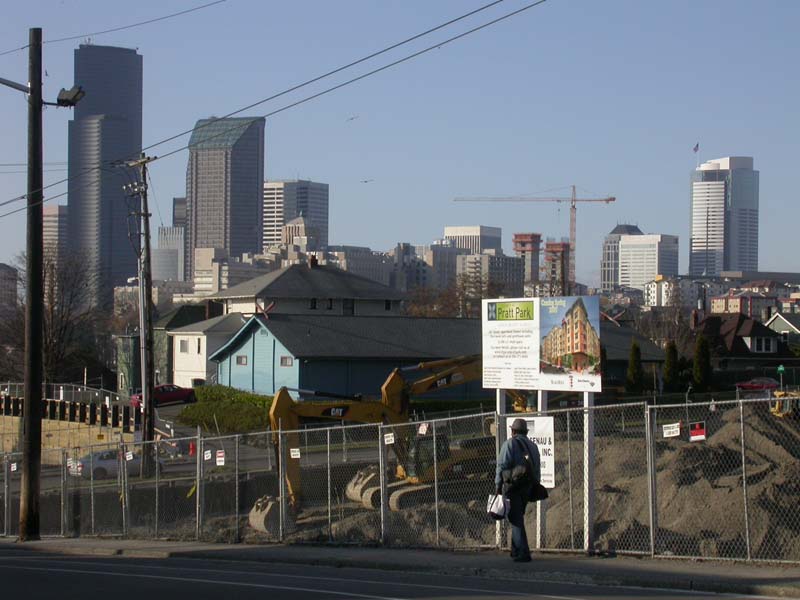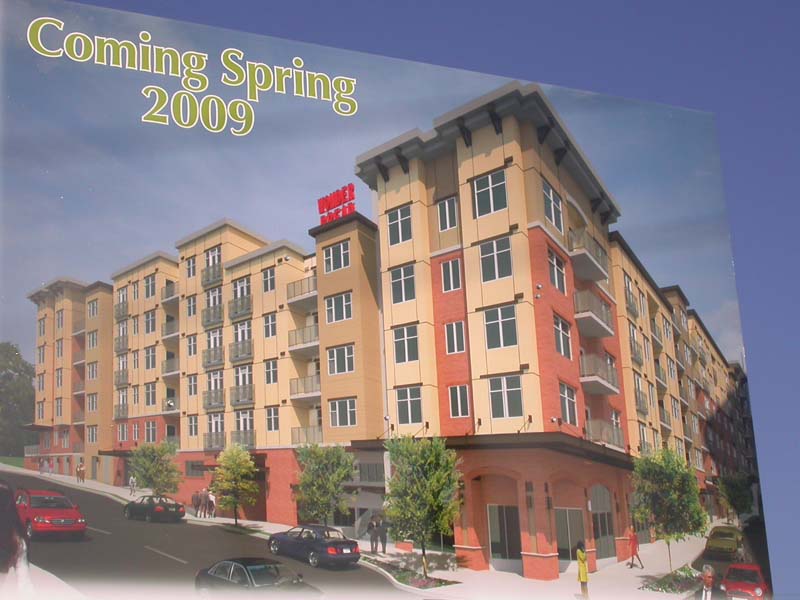‘hood context

What Seattle neighborhood is home to this beauty?

“Already, in the architecture and layout of the new community, one sees the knowledge and discipline that the machine has provided turned to more vital conquests, more human consummations. Already, in imagination and plan, we have transcended the sinister limitations of the existing metropolitan environment. We have much to unbuild, and and much more to build: but the foundations are ready: the machines are set in place and the tools are bright and keen: the architects, the engineers, and the workmen are assembled. None of us may live to see the complete building, and perhaps in the nature of things the building can never be completed: but some of us will see the flag or fir tree that the workers will plant aloft in ancient ritual when they cap the topmost story.”
– Lewis Mumford, closing paragraph of The Culture of Cities, published 1938
18th and Jackson is less than a mile from some of the most expensive real estate in Pacific Northwest, so the curious thing isn’t why redevelopment is happening now, but rather, what the heck took so long?
 The photo above is looking NW across the site of the development known as “Legacy at Pratt Park,” a six-story mixed-use residential building that will cover the entire block between 18th and 19th, north of Jackson. The building, designed by Sienna Architecture, looks to be standard issue Seattle-style “5 over 1”, see below. The red sign atop the building was salvaged from the Wonder Bread factory that was previously on the site.
The photo above is looking NW across the site of the development known as “Legacy at Pratt Park,” a six-story mixed-use residential building that will cover the entire block between 18th and 19th, north of Jackson. The building, designed by Sienna Architecture, looks to be standard issue Seattle-style “5 over 1”, see below. The red sign atop the building was salvaged from the Wonder Bread factory that was previously on the site.

Next door to the west on Jackson is a second, similar project under construction, covering half of the block between 18th and 17th. Designed by Streeter Architects, it appears to range between 4 and 5 stories, see rendering below.
It’s great to finally see infill development along Jackson, but not so fast: why aren’t these buildings taller? This section of Jackson is a wide commercial artery that does not abut any single family zones. Furthermore, within half a block of each of these two projects is a 10-story apartment building, see below. Current zoning along Jackson allows a 65-foot building between 18th and 19th, and only a 40-foot building between 17th and 18th. Huh? Note to Seattle: if you really want to densify, four to six stories ain’t gonna cut it.


Did you hear about the new First Hill Streetcar? Didn’t think so. Sound Transit is making real plans, but not many seem to have noticed. It will run from the International District up Jackson to 12th, north to Boren, then all the way to John on Broadway. Apparently an extension north on Broadway to Aloha is also being considered.
The rationale is that it will make up for the First Hill light rail station that got the ax because we’re to cheap to do it right. So if you’re bound for First Hill, one day you’ll be able to get off light rail at Broadway and Denny, come up and finish your journey on a street car instead of a bus.
I like streetcars but can’t help feeling some ambivalence over this one. It would be great for business on Broadway, no doubt. But it doesn’t seem like money very well spent in terms of the numbers of people it will serve. And the argument that it will be a catalyst for focussed new development doesn’t really apply since most of the route is already densely developed.
It will be interesting to see how the community reacts when this project gets closer to being real. The perceived success of the SLUT (South Lake Union Trolley) will likely have an influence on the public’s appetite for more streetcars.
The 1 Hotel and Residences, currently under construction at 2nd and Pine: “…luxury eco-friendly …daring to be the best of everything but never at the sacrifice of the greater environment at large.”
So it’s good that the building has some green features. But it also caters to a clientele likely to have some honkin carbon footprints. Progress?

It’s not that we’re here to make the argument that Seattle is a hugeass city. Heavens no. Rather, this is a blog about the concept of hugeass cities, and Seattle as interpreted through the hugeass city lens. In the context of the megacities of the world, Seattle could never be fairly described as hugeass. But in terms of the historic scale of human communities, well, perhaps a crass, dude-age word like hugeass fits. Considered charitably, hugeass seems to imply, “whoa, this thing is way fuggin big and there’s tons of shit going down that I don’t understand.” But the truth is, hugeass is a word that means many things to many people, and absolutely nothing to more than a few. And that’s why I like it.
Maybe Seattle wants to be a hugeass city. Maybe it already is. Maybe it thinks it is but really isn’t. Maybe it never will be no matter how hard it tries. Whatever. What matters is that Seattle is definitely changing from whatever it is now to something else, and it seems to be doing it pretty quickly. This blog is here to document that change, to cheer it, to whine about it, and to interpret it against the backdrop of hugeass cities, from time immemorial, to the present, and into the future. Capiche?

Predictable PI column whining about Critical Mass. The writer is a cyclist himself – analogous to conservatives showcasing an African American who doesn’t like affirmative action. But even cyclists often succumb to carhead. The writer would seem to gauge the moral value of any action by whether it causes delays in car travel. Oh, and how clever to drag out the tired straw man that bikers who complain about cars are hypocrites if they use cars. It’s like saying that people who have sex are hypocrites if they disapprove of rape.
I’ve been a daily bike commuter in Seattle for years, though I’ve never ridden in Critical Mass. But I totally appreciate the frustration that feeds it. Given the current state of the planet, you’d think that the average Seattlite would have nothing but gratitude for anyone willing to travel by bike. But what you experience out there on a bike is pretty much the opposite. It’s maddening.
So maybe CMers are taking the chance that their tactics may backfire to some degree. But I love how they openly challenge our car-dominated culture.

Driving through SoDo to Georgetown today I was struck by the vastness of the industrial landscape. Lowrise industrial buildings and parking lots full of trucks seem to stretch for miles in all directions. And so I couldn’t help wondering about all the concern over converting a relatively small area of industrial uses on the south downtown waterfront to housing or office. Is there really a shortage of industrial lands? How well-utilized is the land currently zoned for industrial?   Just based on looking around down there in SoDo, I get the impression that the land is not that well-utilized, i.e. there are many abandoned buildings and empty lots.
And then there’s that huge Costco and its acres of parking lot on 4th Ave. Did I miss the outcry over retail replacing industrial when the Costco was proposed? Don’t think so.
Clearly most city leaders have decided that it is politically expedient to be perceived as protectors of industrial uses in Seattle, especially when the scapecoat can be those evil condo developers. No question that industry is important for a diverse economy in Seattle, but as the city grows one might reasonably expect some industrial uses to move, just as other uses do. For example, does it make sense any more to have industrial uses in a relatively remote neighborhood like Ballard that will probably be adding 50% to its population in the next decade or two?